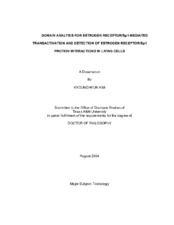| dc.description.abstract | Estrogen Receptor ? (ER?)/Sp1 activation of GC-rich gene promoters in breast cancer cells is dependent, in part, on the activation function 1 (AF1) of ER?. This study investigates contributions of the DNA binding domain (C) and AF2 (DEF) regions of ER? on activation of ER?/Sp1. 17Beta-estradiol (E2) and the antiestrogens 4-hydroxytamoxifen and ICI 182,780 induced reporter gene activity in MCF-7 and MDA-MB-231 cells cotransfected with human or mouse ER? (hER? or MOR), but not ER? and GC-rich constructs containing three tandem Sp1 binding sites (pSp13) or other E2-responsive GC-rich promoters. Estrogen and antiestrogen activation of hER?/Sp1 was dependent on overlapping and different regions of the C, D, E, and F domains of ER?. Antiestrogen-induced activation of hER?/Sp1 was lost using hER? mutants deleted in zinc finger 1 (amino acids (aa) 185-205), zinc finger 2 (aa 218-245), and the hinge/helix 1 (aa 265-330) domains. In contrast with antiestrogens, E2-dependent activation of hER?/Sp1 required the C-terminal F domain (aa 579-595), which contains a ?-strand structural motif. Moreover, in peptide competition experiments overexpression of NR-box peptides inhibits E2-induced luciferase activity of pERE3, which contains three tandem repeats of consensus ERE sites, whereas E2-induced hER?/Sp1 action was not inhibited by NR-box peptide expression. In contrast, overexpression of a C-terminal (aa 575-595) F domain peptide specifically blocked E2-dependent activation of hER?/Sp1, but not on activation of pERE3, suggesting that F domain interactions with nuclear cofactors are specifically required for ER?/Sp1 action.
Furthermore, direct physical interactions between hER? and Sp1 protein in vivo have been investigated by using Fluorescence Resonance Energy Transfer (FRET) microscopy and image analysis. Consistent with results from transient transfection assay, E2, 4OHT, and ICI enhanced hER?/Sp1 interactions in living cells and these interactions were also confirmed by coimmunoprecipitation. In addition, endogenous hER?/Sp1 action was evaluated by using si RNA for Sp1 and a significant decrease in ligand-induced hER?/Sp1 action was observed after decreased Sp1 expression. | en |


